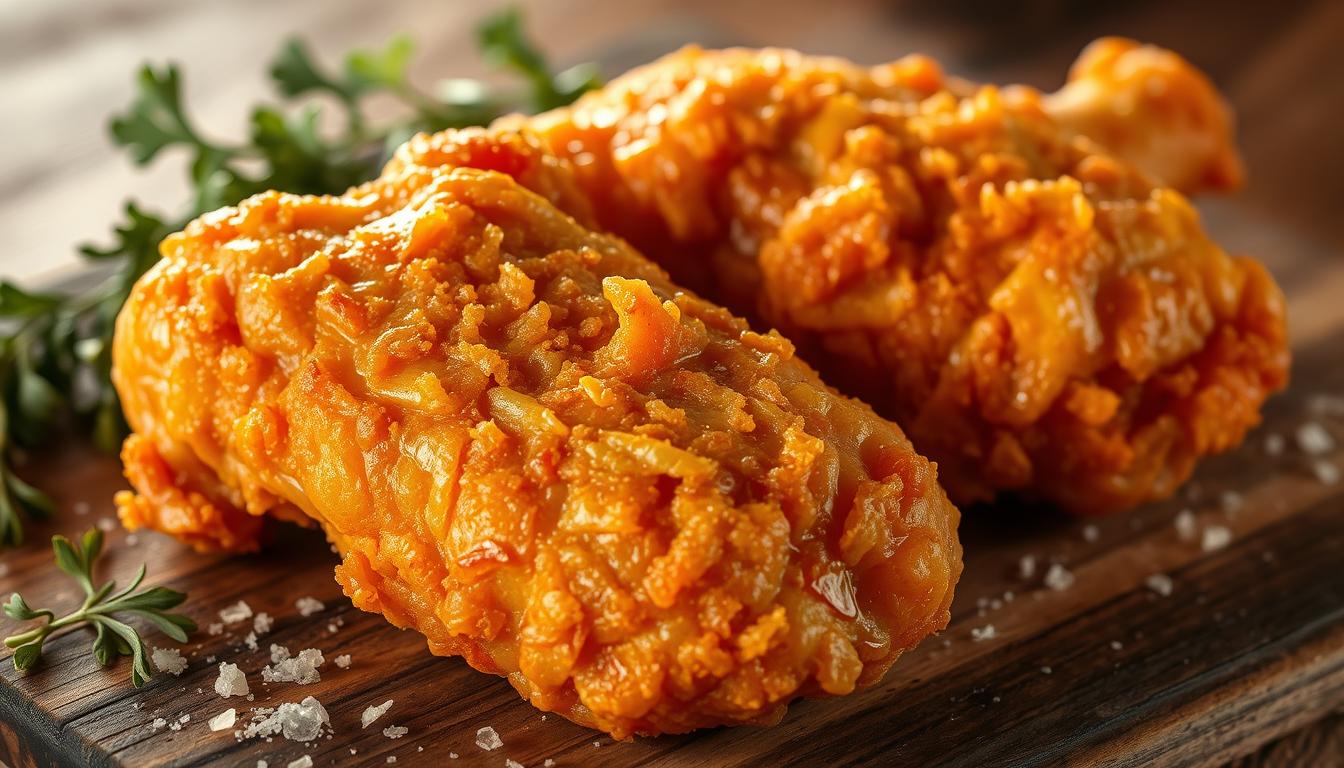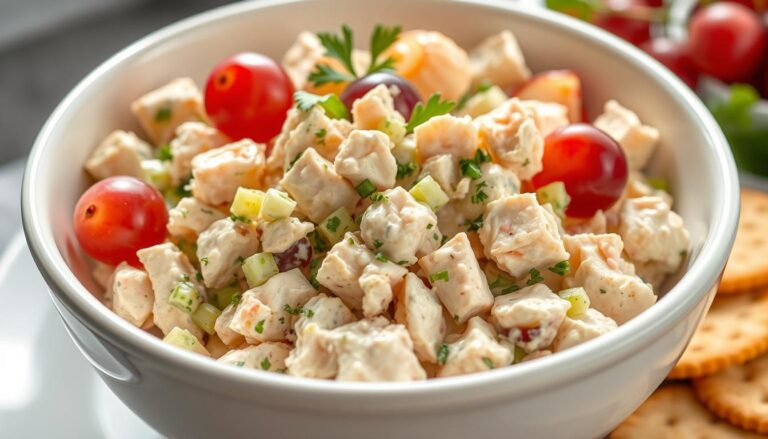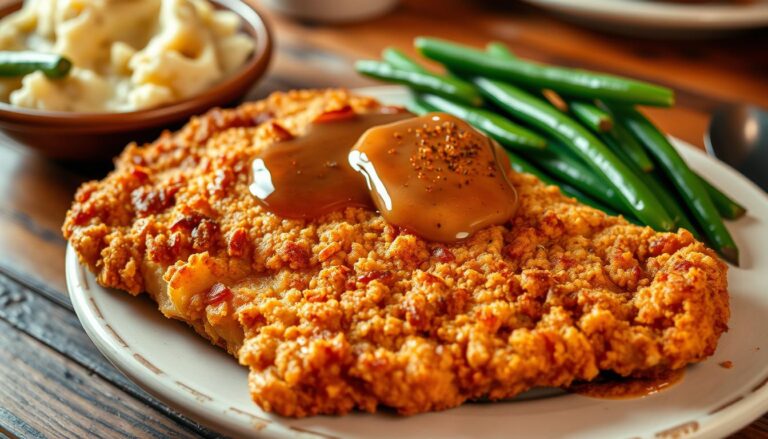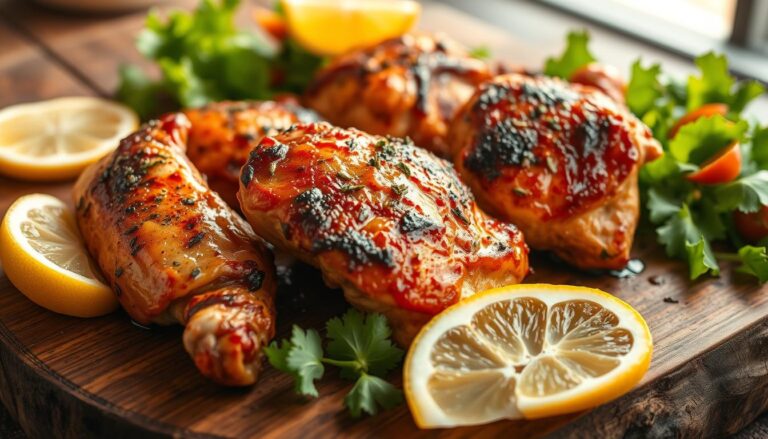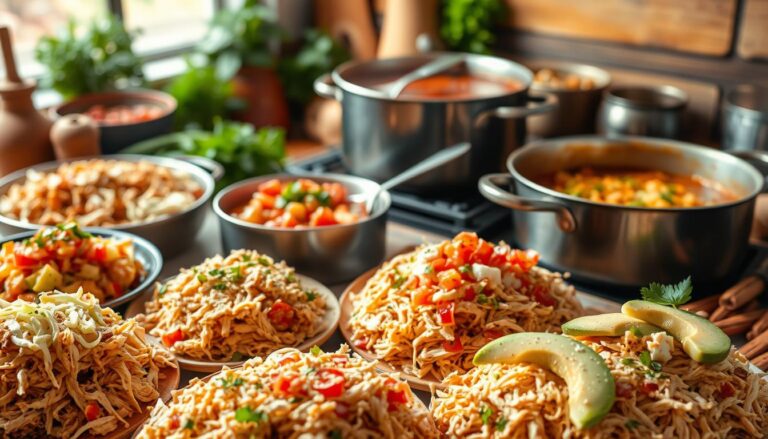Crispy Fried Chicken: A Mouthwatering Classic
Crispy fried chicken is a beloved American dish that has been a staple in many cuisines, particularly in the Southern United States.
The allure of Southern-style fried chicken lies in its perfect balance of crunch and flavor, making it a mouthwatering classic that many enjoy.
To achieve this culinary delight, understanding the science behind the fried chicken recipe is crucial. It’s not just about the ingredients, but also the technique that makes all the difference.
Key Takeaways
- Understanding the history and science behind crispy fried chicken
- Learning various cooking methods for achieving perfect crispiness
- Exploring different fried chicken recipes for inspiration
- Discovering tips for making mouthwatering crispy fried chicken at home
- Mastering the art of Southern-style fried chicken
The Rich History of Fried Chicken in American Cuisine
From its humble beginnings to its current status as a comfort food icon, fried chicken’s history is deeply intertwined with American culture. The dish has undergone significant transformations, influenced by various cultural and culinary factors.
From Scottish Immigrants to Southern Staple
Fried chicken’s origins can be traced back to Scottish immigrants who brought their frying techniques to America. Over time, the dish became a staple in Southern cuisine, with African American communities playing a crucial role in its development.
The use of seasonings and marinades was a significant contribution, enhancing the flavor and texture of fried chicken. This blending of culinary traditions resulted in a unique Southern-style fried chicken that became a regional staple.
| Influence | Contribution |
|---|---|
| Scottish Immigrants | Frying Techniques |
| African American Communities | Seasonings and Marinades |
How Fried Chicken Became a Cultural Icon
Fried chicken’s rise to cultural icon status can be attributed to its widespread popularity and versatility. It has been featured in various cultural events, from family gatherings to music festivals.
Key factors in its cultural significance include:
- Regional variations that showcase local flavors and preferences
- Influence on popular culture, with references in music and film
- Adaptability to different culinary trends and dietary preferences
What Makes the Perfect Crispy Fried Chicken
The quest for the perfect crispy fried chicken involves understanding the science behind crispiness. Achieving the ideal crispiness is not just about the ingredients, but also about the cooking technique and temperature control.
The Science of Crispiness
The Maillard reaction, a chemical reaction between amino acids and reducing sugars, is the key to achieving crispiness. When the chicken is cooked, the heat triggers this reaction, resulting in the formation of new flavor compounds and browning. To maximize the Maillard reaction, it’s essential to use the right cooking oil and maintain the optimal temperature.
Optimal frying temperatures range between 350°F and 375°F. At this temperature range, the chicken cooks evenly, and the exterior becomes crispy. Using a thermometer can help you achieve precise temperature control.
| Frying Temperature | Cooking Time | Result |
|---|---|---|
| 350°F | 8-10 minutes | Golden brown and crispy |
| 375°F | 6-8 minutes | Deep golden brown and crunchy |
Balancing Texture and Flavor
Balancing texture and flavor is crucial for perfect crispy fried chicken. The coating should be crunchy on the outside and tender on the inside. To achieve this, you can use a combination of all-purpose flour, cornstarch, and spices.
https://www.youtube.com/watch?v=Hv-fDUVUuJw
Experimenting with different seasonings can help you find the perfect balance of flavors. Popular seasonings include paprika, garlic powder, and onion powder.
Essential Ingredients for Authentic Fried Chicken
To achieve that perfect crunch and flavor, you need to start with the essentials. The quality of your fried chicken is directly related to the quality of its components. Let’s dive into the crucial elements that make up authentic fried chicken.
Choosing the Right Chicken Parts
Selecting the right chicken parts is fundamental. You can opt for legs, thighs, wings, or breasts, depending on your preference. Dark meat, such as thighs and legs, tends to be juicier and more flavorful, while white meat like breasts is leaner. A mix of both can provide a well-rounded fried chicken experience.
The Perfect Flour Mixture
The flour mixture is a critical component of the coating. All-purpose flour is a staple, but you can enhance it by adding cornstarch or potato starch for extra crispiness. The ratio can vary, but a common mix is 75% all-purpose flour and 25% cornstarch or potato starch.
Seasonings That Make a Difference
Seasonings elevate the flavor of your fried chicken. Paprika, garlic powder, onion powder, and cayenne pepper are popular choices. You can also add herbs like thyme or oregano to give it a unique twist. The key is to balance the flavors so that no single seasoning overpowers the others.
Equipment You’ll Need for Restaurant-Quality Results
To make crispy fried chicken that’s on par with your favorite restaurant, you’ll need some essential equipment. The right tools can make a significant difference in the quality of your fried chicken, ensuring it’s cooked to perfection every time.
Selecting the Right Cooking Vessel
Choosing the appropriate cooking vessel is crucial for achieving that perfect crispiness. You have a couple of excellent options: a deep fryer or a cast-iron skillet. A deep fryer is ideal because it allows for precise temperature control and can handle large quantities of oil, making it perfect for frying chicken in batches. On the other hand, a cast-iron skillet is a versatile option that can be used for frying on the stovetop or even in the oven. It retains heat well, which is essential for cooking fried chicken evenly.
Temperature Control Tools
Temperature control is vital when it comes to frying chicken. The ideal frying temperature is between 350°F and 375°F. To achieve this, you’ll need a reliable thermometer. There are different types of thermometers available, including instant-read thermometers and probe thermometers that can be left in the oil. These tools help you monitor the oil temperature, ensuring that it remains consistent throughout the frying process, which is crucial for achieving crispy and golden-brown fried chicken.
By investing in the right cooking equipment and temperature control tools, you’ll be well on your way to making restaurant-quality fried chicken at home. Remember, the key to perfect fried chicken lies in the details, and having the proper equipment is the first step towards achieving that perfect crispiness.
The Art of Brining and Marinating
The secret to succulent fried chicken lies in the process of brining and marinating, which adds moisture and flavor. Brining involves soaking the chicken in a saltwater solution to enhance its natural flavors and texture, while marinating infuses the meat with additional flavors from herbs, spices, and other ingredients.
Buttermilk Brine: The Secret Weapon
A buttermilk brine is a game-changer for fried chicken. The acidity in buttermilk tenderizes the chicken, making it juicy and tender on the inside while crispy on the outside. To make a buttermilk brine, combine buttermilk with salt, sugar, and your choice of herbs and spices. Let the chicken soak in this mixture for at least 2 hours or overnight for the best results.
Flavor-Infusing Marinades
Marinades can elevate the flavor profile of your fried chicken. You can create a marinade using a mixture of olive oil, garlic, paprika, and other spices. The key is to balance the flavors so that they complement the natural taste of the chicken without overpowering it. Experiment with different marinade recipes to find your signature flavor.
| Brining/Marinating Method | Key Ingredients | Benefits |
|---|---|---|
| Buttermilk Brine | Buttermilk, Salt, Sugar, Herbs, Spices | Tenderizes chicken, adds moisture, and flavor |
| Flavor-Infusing Marinades | Olive Oil, Garlic, Paprika, Spices | Enhances flavor profile, adds depth |
Mastering the Dredging Process
The art of dredging is what sets great fried chicken apart from the rest. It’s a simple yet crucial step that requires attention to detail to achieve that perfect golden-brown crust.
Single vs. Double Dredging Techniques
Dredging techniques can significantly impact the final texture of your fried chicken. Single dredging involves coating the chicken in a flour mixture once, which can result in a lighter coating. On the other hand, double dredging involves dipping the chicken in a wet ingredient like buttermilk before coating it in flour, then repeating the process. This technique yields a crunchier exterior.
Choosing between single and double dredging depends on your desired outcome. For a lighter coating, single dredging might be sufficient. However, for a crunchier exterior, double dredging is the way to go.
Creating the Perfect Coating Texture
Achieving the perfect coating texture is all about balance. The coating should be thick enough to provide crunch but not so thick that it overpowers the chicken.
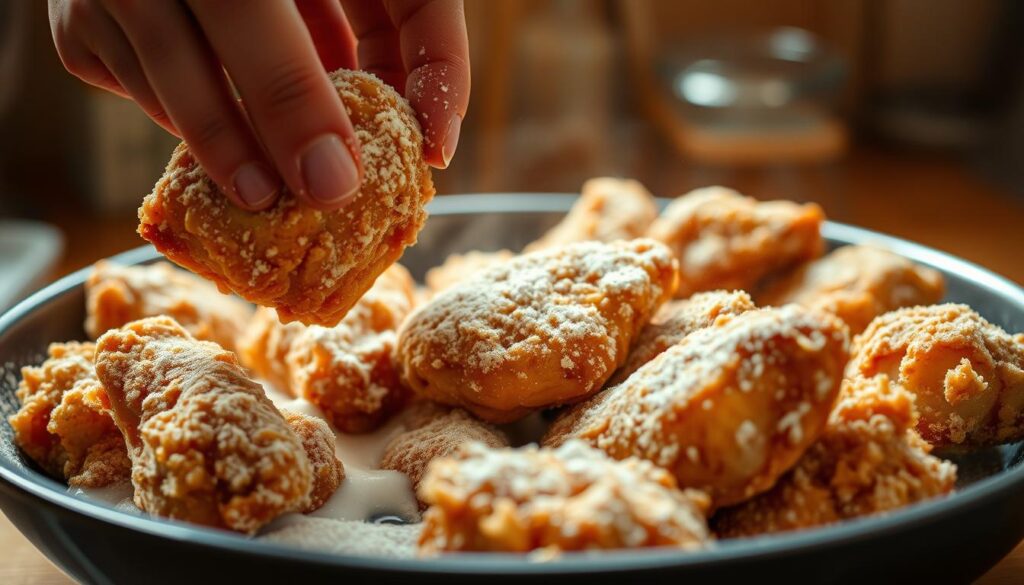
Using the right flour mixture and not overloading the chicken with coating are key. Experimenting with different seasonings in your flour can also enhance the texture and flavor.
By mastering the dredging process, you can elevate your fried chicken game and achieve that perfect crispy exterior that everyone loves.
Crispy Fried Chicken: Step-by-Step Cooking Method
The secret to mouthwatering crispy fried chicken lies in a well-executed step-by-step cooking process. To achieve this, it’s crucial to understand the key elements involved in cooking crispy fried chicken.
Oil Temperature Management
Managing oil temperature is critical for achieving crispy fried chicken. The ideal temperature for frying chicken is between 350°F and 375°F. Maintaining this temperature range ensures that the chicken cooks evenly and the exterior becomes crispy.
Frying Times for Different Chicken Parts
Frying times vary depending on the chicken parts being cooked. Here’s a general guideline:
| Chicken Part | Frying Time |
|---|---|
| Wings | 8-10 minutes |
| Legs | 12-15 minutes |
| Thighs | 12-15 minutes |
| Breasts | 15-18 minutes |
Achieving That Golden-Brown Finish
To achieve a golden-brown finish, it’s essential to not overcrowd the frying vessel. Fry in batches if necessary, to ensure each piece has enough room to cook evenly. Monitoring the oil temperature and adjusting the heat as needed will also help in achieving the perfect color.
Resting and Draining Properly
After frying, it’s crucial to let the chicken rest on a wire rack or paper towels to drain excess oil. This step helps maintain the crispiness of the fried chicken. Proper resting and draining ensure that the chicken remains crispy and flavorful.
Regional Variations of Fried Chicken Across America
Fried chicken, a staple of American cuisine, has evolved into various regional styles across the United States. This beloved dish has been adapted and modified to suit local tastes, resulting in a diverse array of flavors and cooking techniques.
Southern-Style vs. Nashville Hot
The Southern United States is renowned for its traditional fried chicken, characterized by a crispy exterior and juicy interior. Nashville hot chicken, a variation from Tennessee, is known for its spicy kick and is often served with local specialties like pickles and bread. As food critic, John T. Edge, once said, “Nashville hot chicken is a culinary experience that will leave you wanting more.”
“Nashville hot chicken is a love letter to the South, with its crispy, spicy, and succulent flavors.”
Priya Krishna, Food Writer
Korean-American Fusion Fried Chicken
Korean-American fusion fried chicken has gained popularity in recent years, particularly on the West Coast. This style combines traditional Korean flavors like gochujang and soy sauce with the classic American comfort food. The result is a unique and flavorful twist on traditional fried chicken.
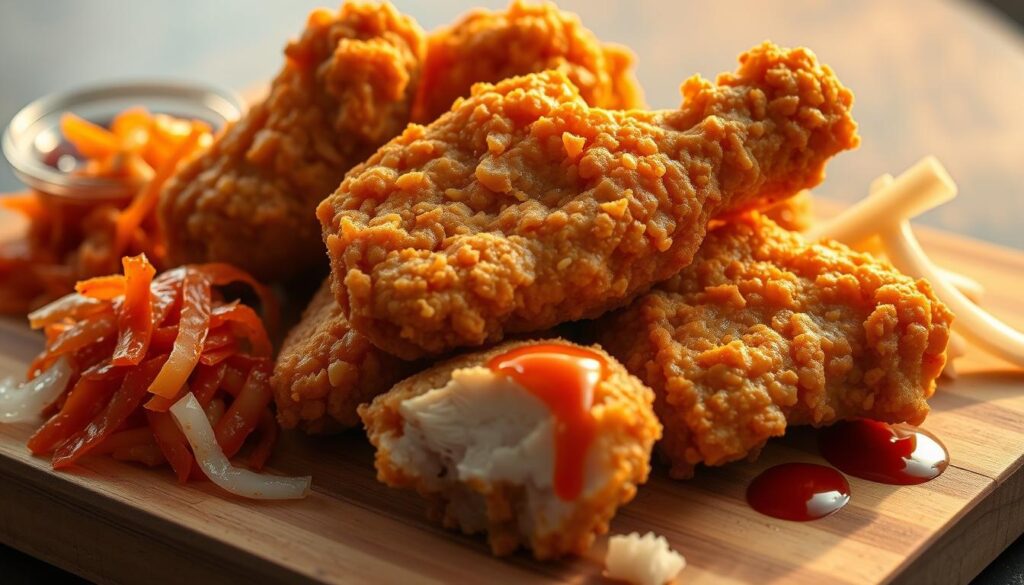
Other Notable Regional Styles
Other regional styles worth mentioning include the Texas-style fried chicken, known for its bold flavors and spices, and the Memphis-style, which often incorporates local ingredients like barbecue sauce. These regional variations showcase the diversity and creativity of American fried chicken.
- Texas-style: bold flavors and spices
- Memphis-style: incorporates barbecue sauce
- Southern-style: traditional and comforting
Healthier Approaches to Crispy Fried Chicken
Discover how to enjoy crispy fried chicken with a healthier twist. While traditional fried chicken is a beloved comfort food, there’s a growing interest in making it healthier without sacrificing flavor.
Air Fryer and Oven-Baked Alternatives
One of the simplest ways to make fried chicken healthier is by using an air fryer or oven-baking it. An air fryer uses little to no oil, achieving that crispy exterior and juicy interior with a fraction of the calories. To air fry chicken, preheat the air fryer to 400°F (200°C), season the chicken as desired, and cook for about 20-25 minutes, shaking halfway through. For oven-baking, preheat to 425°F (220°C), place the chicken on a baking sheet lined with parchment paper, and bake for about 30-35 minutes, or until crispy and cooked through.
Gluten-Free and Dietary Adaptations
For those with dietary restrictions, making gluten-free fried chicken is easier than ever. Use gluten-free all-purpose flour or a combination of rice flour, cornstarch, and spices for the coating. Another option is to use almond flour or coconut flour for a low-carb version. Here’s a simple comparison of different coating options:
| Coating Type | Gluten-Free | Low-Carb |
|---|---|---|
| All-purpose flour | No | No |
| Gluten-free flour | Yes | No |
| Almond flour | Yes | Yes |
By making these simple adjustments, you can enjoy crispy fried chicken that fits your dietary needs.
Storing and Reheating Your Fried Chicken
With the right storage and reheating techniques, you can enjoy crispy fried chicken for days. The key is to maintain the crispiness that makes fried chicken so delightful.
Proper Storage Techniques
To keep fried chicken crispy, it’s essential to store it properly. Place the chicken in a single layer on a wire rack set over a baking sheet and refrigerate uncovered. This allows air to circulate around the chicken, helping to maintain its crispiness.
Methods for Maintaining Crispiness When Reheating
When reheating, use an oven or air fryer to restore crispiness. Preheat to 375°F (190°C), place the chicken on a baking sheet in a single layer, and heat for about 10-15 minutes, or until crispy. Avoid microwaving, as it can make the coating soggy.
Conclusion: Enjoying America’s Beloved Comfort Food
Crispy fried chicken is more than just a meal; it’s a comfort food that brings people together. With its rich history and cultural significance, it’s no wonder that fried chicken remains a staple in American cuisine.
By mastering the techniques and recipes shared in this article, you’ll be able to create delicious crispy fried chicken that will delight family and friends. Whether you’re cooking for a casual gathering or a special occasion, enjoying fried chicken is an experience that transcends generations.
As you continue to explore the world of fried chicken, remember that the joy of cooking lies not just in the food itself, but in the memories and moments created around the table. So go ahead, savor the flavor, and indulge in the comfort of America’s beloved fried chicken.
FAQ
What is the best way to achieve crispy fried chicken?
To achieve crispy fried chicken, it’s essential to use the right ingredients, such as a buttermilk brine, and cooking techniques, like double dredging, and to maintain the correct oil temperature.
Can I make fried chicken in an air fryer?
Yes, you can make fried chicken in an air fryer, which is a healthier alternative to deep-frying. Simply marinate and dredge the chicken as you normally would, and then cook it in the air fryer at the recommended temperature.
What is the ideal oil temperature for frying chicken?
The ideal oil temperature for frying chicken is between 350°F and 375°F. This temperature range allows for the perfect balance of crispiness and cooking time.
How do I store leftover fried chicken?
To store leftover fried chicken, place it in an airtight container and refrigerate it within two hours of cooking. When reheating, use the oven or air fryer to maintain crispiness.
Can I make gluten-free fried chicken?
Yes, you can make gluten-free fried chicken by using gluten-free flours, such as rice flour or cornstarch, and being mindful of cross-contamination with gluten-containing ingredients.
What are some regional variations of fried chicken in America?
Some notable regional variations of fried chicken in America include Southern-style, Nashville hot, and Korean-American fusion fried chicken, each with its unique characteristics and flavor profiles.
How do I reheat fried chicken to maintain crispiness?
To reheat fried chicken and maintain crispiness, use the oven or air fryer at a moderate temperature, around 350°F, for a short period, usually 5-10 minutes, until crispy and hot.
What is the benefit of using a buttermilk brine for fried chicken?
Using a buttermilk brine for fried chicken adds moisture, tenderness, and flavor to the chicken, making it more delicious and crispy.
Can I make fried chicken without a thermometer?
While it’s possible to make fried chicken without a thermometer, it’s not recommended, as it can be challenging to achieve the correct oil temperature, which is crucial for crispy fried chicken.

